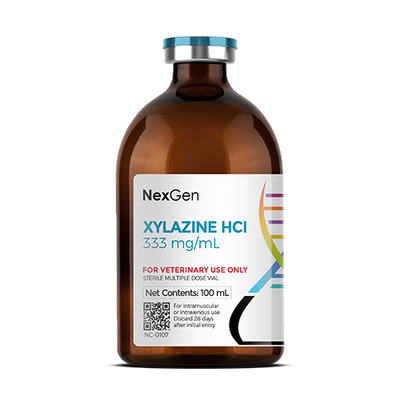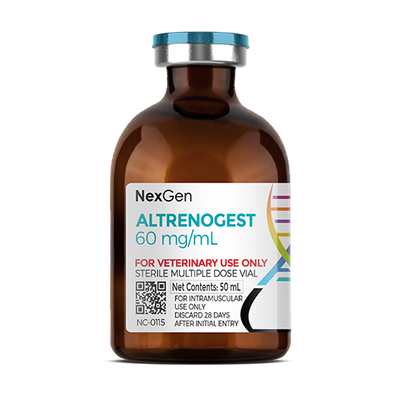
Xylazine 300 mg/mL, Injectable, (30mL)
Login for pricing
- Brand
- Mixlab
- SKU:
- NC-0528
- Product Type:
- Injectable
- Size:
- 30ml
- Administration:
- Intravenous
Xylazine (Xylazine HCl) is an alpha-2-adrenergic agonist (α2- adrenergic agonist) that is used as a sedative and analgesic agent in a variety of species, as well as an emetic in cats. Xylazine has a long-standing use for surgical procedures in small animal practices, but it is also used in large animal and wildlife applications. In veterinary anesthesia, xylazine is often used in combination with ketamine.
The sedative and analgesic activity of xylazine is related to central nervous system depression. It provides muscle relaxation based on inhibition of the intraneural transmission of impulses in the central nervous system.2 The degree of CNS inhibition is such that xylazine provides dose-dependent, deep muscle relaxation and respiratory depression without inhibition of the nervous system’s more critical functions.
Comparative pharmacokinetics of xylazine in several species was reported by researchers in 1981. Xylazine drug was administered intravenously and intramuscularly at recommended doses. The data was generated by analyzing serum drug concentration in samples obtained at 1, 2, 4, 8, 16, 30 and 120 min after xylazine administration. Compartmental analysis of the data was performed and the data best fitted a two-compartment open model.3,4
Table 1. Major pharmacokinetic parameters of xylazine in horse, cattle, sheep and dog after intravenous administration at 0.6, 0.2, 1.0 and 1.4 mg/kg, respectively:4
| Parameter | Horse (n = 4) | Cattle (n = 4) | Sheep (n = 6) | Dog (n = 4) |
| Weight (kg) | 415-550 | 240-440 | 42-65 | 14-24 |
| t1/2 (min) | 50 | 36 | 25 | 30 |
| CLb (ml/min/kg) | 21 | 42 | 83 | 81 |
| Vd(area) (l/kg) | 2.4 | 1.9 | 2.7 | 2.5 |
The terminal half-life of xylazine in all species was short, indicating that xylazine concentration would decrease to undetectable level within a few hours. The total body clearance varied significantly and was fastest in sheep and dog and slowest in horse. Xylazine clearance has been attributed mainly to metabolic clearance. Therefore, there seems to be species variations in the metabolic rate of the drug. The volume of distribution was large in all species apparently because of the lipophilic nature of the compound.4
The pharmacokinetic parameters after IM administration are given in Table 2. There were no differences in the half-lives after IM administration when compared to those after IV administration. The Tmax values were reached within 15 minutes from drug administration and the peak concentrations were very low. Because of the low concentrations of the drug in bovine plasma, pharmacokinetic parameters after IM administration could not be determined in cattle.4
Table 2. Major pharmacokinetic parameters of xylazine in horse, cattle, sheep and dog after intramuscular administration at 0.6, 0.2, 1.0 and 1.4 mg/kg, respectively:4
| Parameter | Horse (n = 4) | Cattle (n = 4) | Sheep (n = 6) | Dog (n = 4) |
| Weight (kg) | 415-550 | 240-440 | 42-65 | 14-24 |
| t1/2 (min) | 58 | N.D. | 22 | 35 |
| Tmax (min) | 13 | N.D. | 15 | 13 |
| C(max) (m g/ml) | 0.2 | N.D. | 0.1 | 0.4 |
Emergent Abuse Warning
The illicit use of xylazine among injecting drug users (IDUs) on the island of Puerto Rico (a territory of the United States) has drawn significant attention. Clinical findings reported that xylazine users presented limb skin lesions, ulcerations and greater physiological deterioration than heroin users only. Because human xylazine use has been reported in other locations outside of Puerto Rico, this substance could also emerge as an adulterant in other markets.5
Adverse Effects
Side effects of xylazine can include muscle tremors, seizures or slowed heart rate with partial heart block and slowed breathing rate. Increased urination sometimes occurs in cats. Dogs can swallow excess air and can bloat under the effects of xylazine, with stomach tubing being necessary to remove excess air in the stomach. Vomiting can occur following xylazine administration in dogs and cats.3
Where to Buy Xylazine
Xylaxine is available in the U.S. through pharmaceutical manufacturers and through veterinary custom compounding companies. Please consult your veterinarian prior to beginning any treatment regimen.
FOR RX ONLY: A valid prescription from a licensed veterinarian is required for dispensing this medication.
2Khursheed R., et. al. Evaluation of xylazine and ketamine for total intravenous anesthesia in horses, American Journal of Veterinary Research 2005 66:6, 1002-1007.
4Garcia-Villar, R., Toutain, P-L., Alvinerie, M. and Ruckebusch, Y., (1981). The pharmacokinetics of xylazine hydrochloride: An interspecific study. J. Vet. Pharmacol. Therap. 4, 87-92.
5Torruella, R.A. Xylazine (veterinary sedative) use in Puerto Rico. Subst Abuse Treat Prev Policy 6, 7 (2011). https://doi.org/10.1186/1747-597X-6-7




















